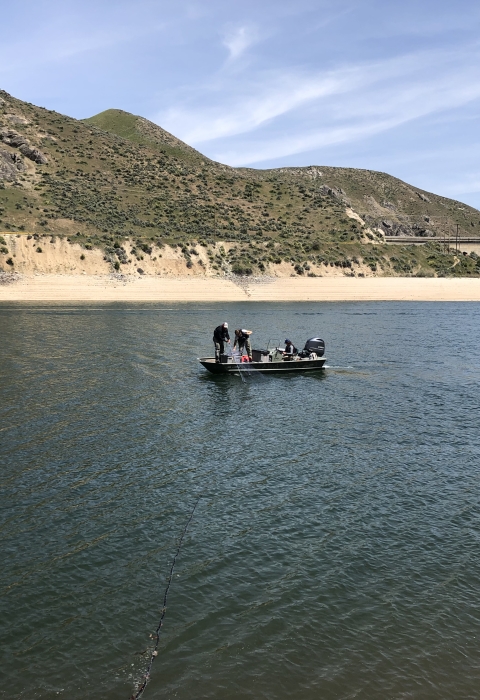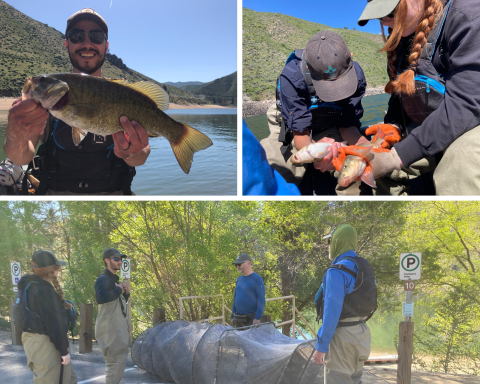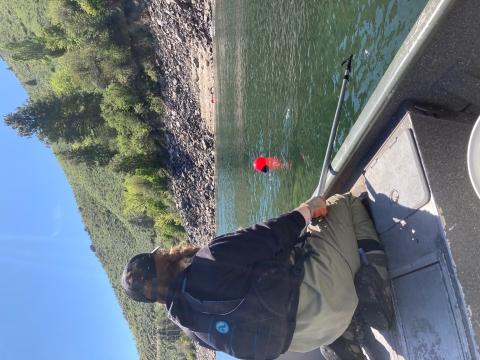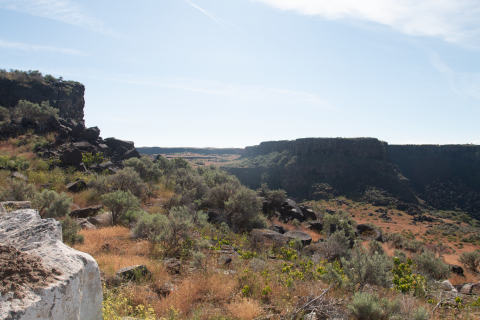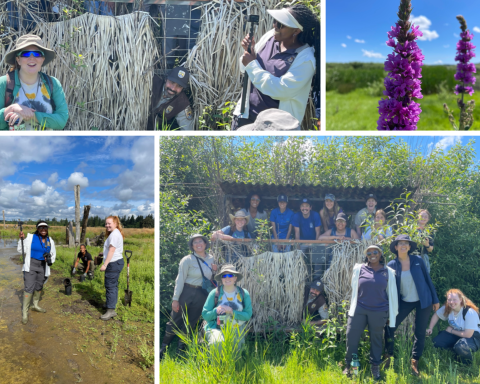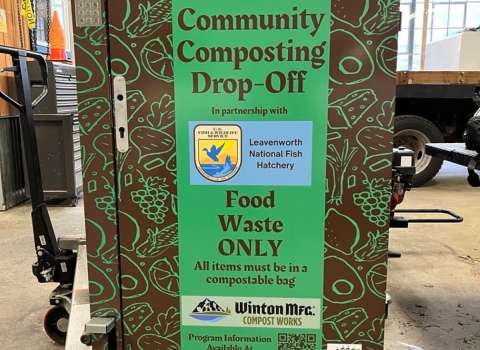School’s out for the summer! For many of us, that means lazy, hot days relaxing in the shade or adventurous travel, but this year, for me, it means embarking on a summer internship for the U.S. Fish and Wildlife Service (USFWS). I wasn’t really sure what to expect, except that my packing list included sunscreen, bug repellant, and chest waders (required). On my first day in the field, I was able to put all three of these things to good use!
There was no opportunity to sleep in, as the meet up time was 6:30 am, and this was especially harsh, coming from a more western time-zone. Day one of fieldwork was spent working with a partner agency — Bureau of Reclamation (BOR) — to locate, catch, and relocate bull trout. Bull trout are listed as threatened under the Endangered Species Act (ESA), and USFWS is charged with managed listed species. The BOR needs to monitor bull trout to determine the effects of their water management projects on the species. So, my fellow intern and I learned how to trap fish, utilizing gill nets. While gill nets can be dangerous to fish if left for a significant amount of time, when used carefully, they can be an expedient, effective method of finding fish in their natural habitat.
Although most fishing excursions usually set out in hopes of catching fish, we were actually glad that we didn’t locate any bull trout that needed to be trapped and hauled to a different reservoir. Fish passage is not available at Arrowrock Dam so any bull trout caught in Lucky Peak Reservoir need to be transported above the dam in order to migrate and spawn in their natal streams. The lack of bull trout in this area likely means that BOR’s adaptive management of the project minimizes entrainment at Arrowrock Dam. We recorded the other fish we did capture: Large-scale suckers and bridge lip suckers were the most common species we pulled up. We also discovered a single white fish, a Northern Pike minnow, and a furious log that knotted the entire net. After we pulled in a net and recorded the fish, we gently released them back into the water.
The system we used was to have four nets going at a time and it worked like this: Set the first four on one side of the river, waited 30 minutes then went to collect the first net we set. Every time we pulled up a net, we set it somewhere else then went back to the second placed net and so on. We set and reset the nets for about four hours while the other intern and I switched between doing data or nets with the other biologists.
I expected to feel nervous about touching the fish to free them from the nets, but I surprised myself by not being bothered. They were soft on their sides and sharp and bony along their back. It was very cool to see them so up close and how they responded to us. Some of the fish were dubbed “drama queens”. Today, I learned about fish capture techniques and the reasons why we were doing it. More importantly, I learned about how the ESA not only inspires diverse partnerships to prevent species extinctions and recover listed species, it also supports proactive collaborations with states, private landowners, conservation groups and industry to conserve species.
By Hallie Morris, University of Idaho
Fieldwork Fun: Day Two — Rare snails Can’t Slow Me Down
Continuing the adventure, my fellow intern and I woke up bright and early to travel to Twin Falls, Idaho. Our destination: Devil’s Corral to make some Gastropoda history!
The site, just above Shoshone falls, is pretty special because it is a natural barrier to many species. The canyon has two arms of spring-fed creeks that run through the site and drain into the Snake River. Additionally, because these two arms contain spring water, it makes the area the ideal habitat for our target shelled friend, the Bliss Rapids snail.
Everything about this snail is small: its size, population range, as well as public knowledge of the species. The snail, on average, is smaller than a pencil eraser and the younger snails can be as small as a point of a pencil. They are limited to areas with spring water from the Eastern Snake Plain Aquifer and are endemic to South-Central Idaho. Bliss Rapids snails require cold clear spring water from these areas to survive. They tend to be found in pockets near the banks where the water flow is slower. They are found under rocks of all sizes as they like dark places but do come to the top of rocks at night before moving back to the bottom when first light comes.
After a short snail identification training, we put on our waders and trekked into the waters. It was stinky and sinky at first because we had to get through the vegetation but then we hit our first pool. The survey work was especially exciting because this was the first time this land was surveyed in its entirety for these threatened snails and approximate population counts were unknown. A single pool at the head of the Western arm had been surveyed only to confirm presence of the snails because the land-owners only provided permission for a presence-absence survey. The land-ownership changed, and the new owner is very pro-snail! There is an interest to semi-develop the land into an ecoresort/learning center, snail conservation is also very important to the land-owner. We are all very excited that the land-owner loves these little critters as much as we do, and that he lets us see if his land houses our snail.
It only took about five minutes to find the snail. I was lucky enough to be the first one to find said snails on a fairly big rock (after I double checked with our expert first). After that we found them all over the cobbled areas along the edges of the creek. We double-checked some areas that had white water to make sure we didn’t miss any, even though they are not typically found in fast moving water. Because bliss rapid snail presence is unknown in this area and because they are so rare, their tolerance for discharge rate (water flow) is not certain.
It took us all day but we made it through the first arm and made it to the edge where there was a waterfall that led the water to the Snake River. We found healthy populations of the snail which was very exciting! We also made note of an invasive species invasive species
An invasive species is any plant or animal that has spread or been introduced into a new area where they are, or could, cause harm to the environment, economy, or human, animal, or plant health. Their unwelcome presence can destroy ecosystems and cost millions of dollars.
Learn more about invasive species when we saw it, the New Zealand mudsnail. These snails can resemble the bliss rapid snail but are usually identifiable by the shape of their shell and how many swirls they possess. Bliss rapid snails are more round with few swirls, its shell color is also usually clear though can be a more red and even purple/pink. There were five of us to start and even the landowner and his lead contractor came in wetsuits and wanted to help! One of us kept track of data on a data sheet while the rest of us looked for the snails under the rocks. We picked up a rock making sure to note its location, flipped it over, then looked for snails. We counted how many we found then measured the rock in centimeters with our hands. After we yelled our information to the data recorder we gently placed the rock back where we found it to limit disturbance to the snails and habitat.
Day Three
POV: I’m starting to realize waking up early and getting a head start to the workday is very beneficial when you don’t like the heat and burn very easily (red-head problems).
Today we started our Bliss Rapids snail search on the Eastern arm. This arm already proved to be much more intense than yesterday’s trip. The owner watched us from way up above on the cliff, probably wishing us luck for the journey ahead. We started through a sinky marsh like the day before and hit a block so we went around by climbing onto scree (loose rocks that cover a mountain) and doing some makeshift rock climbing and boulder scrambling. Something new to add to the resume!
Just when I thought things couldn’t get more challenging, I spotted our next obstacle: a waterfall with a cliff on one side and a more forgiving slope on the other. We chose the latter and made our way around the waterfall and butt-scooted down the slope to the water- another new skill to add to my resume! We were not surprised that we didn’t find Bliss Rapids snails at the bottom of a waterfall. We started bushwhacking through the vegetation until we found suitable habitat, and by vegetation, I mean poison ivy and stinging nettle at about every turn. We ended up finding a few snails in that area but not many and moved on. This arm was not very walkable in waders as there was so much vegetation and muck that made you get stuck; we ended up doing a lot more boulder scrambling and forging our own paths. All in all, we had to work really hard for the success of finding the snails here, and I fell, a lot, and got some nettle stings as well. It all seemed worth it because, in areas that were not so sandy and filled with bull rush, we found some pockets of the snails!
We made it through the spring-fed creek with a lot of sweat and grit. The arduous journey was worth it, however, as we found our snail friends and even some cool looking caves in which the water ran through as well. It felt nice to be by the caves and underground water areas as it provided a much needed chill, after a hard day’s work!
by Hallie Morris
Fieldwork Fun Day Four: Planting Party
Today we traveled to the Minidoka Refuge. There was a wildfire a few years before and left some burn scars. After the fire the refuge workers sprayed the areas to keep weeds and invasive plants from growing. We showed up to the site at 7:30 am and started planting soon after. We planted a variety of native grasses and forbs in a burn scar to restore the empty patches back to its native glory.
We started prepping the site by laying down bark in a few places and spreading it out, we also picked and threw invasive species on our plots as we saw them. The procedure was simple: use a tool that created a perfect hole in the ground, place the plant in the hole, fill it back up, compact the dirt down, and then drown that plant in water. We really wanted them to get a good drink so we would hold the hose above it for at least ten seconds.
The five of us easily planted around 1,000 plants that day. They had planted even more the day before my intern partner and myself arrived. It was a fairly hot day but we brought lots of water and were able to cool off by the lake during lunch. I hid from the sun by eating my lunch next to the ATV. Speaking of ATVs, we rode one out as it carried the big water jugs. We had to wear helmets per regulations but it was a fun and bumpy ride. Overall, it was a long and hot day, however, the outcome was great! This post was short and with a sweet end. Never be afraid to reach out to your local refuge to volunteer!
by Hallie Morris
Fieldwork Fun: Mind your MANRRS
Bloggers Note, by Allyson Turner, Public Affairs Officer for the Idaho Fish and Wildlife Office: The U.S. Fish and Wildlife Service has a unique relationship with Minorities in Agriculture, Natural Resources, and Related Sciences (MANRRS) chapters at universities throughout the country. In Region 1, we have an internship program where members of MANRRS chapters work closely with Service programs and learn valuable skills to prepare them for future employment with the Service. The internship program is also designed to be a fun, summer experience, while allowing interns to have a variety of experiences to expose them to all aspects of the Service. It is a mutually beneficial program for our Region where interns have a great summer of learning and Service employees gain additional capacity and practice reverse mentoring to learn from college student interns.
The Following Blog Post is By Hallie Morris, U.S. Fish and Wildlife Service Summer Intern, MANRRS Program
It has been an adventurous summer! My internship with the Pacific Region of the U.S. Fish and Wildlife Service (Service) has introduced me to some incredible people, places, and programs. One of the coolest groups I got to know was the Minorities in Agriculture Natural Resources and Related Sciences (MANRRS) internship program. This week, seven interns met up to collaborate, learn, and, of course, work! We were joined by a few Directorate Fellows Program (DFP) interns, and both of these internships provide students with office, field, and research experience. You can think of MANRRS as a stepping stone to do DFP which provides a pathway to federal employment.
Our adventure took place at Tualatin River National Wildlife Refuge. One of the few urban national wildlife refuges in the nation, Tualatin Refuge is situated on the outskirts of Portland, Oregon. The refuge, which is located within the Tualatin River's floodplain, is home to some of the most numerous and diverse species of animals in the watershed.
The interns and I stayed at a bunkhouse near the refuge and had a great time getting to know each other and sharing stories. Meeting the group of interns, all with similar interests in ecology and the type of work that the Service does, was fun and helped me validate my own conservation career interests. I am really hoping to do unique research after I graduate and pursue a master’s degree or PhD. This summer’s internship has helped me understand the difference between taking an academic career path versus a management route. I would really love to do research that helps managers by understanding how habitat changes can affect the plants and animals they are trying to protect.
The next morning we drove over to the refuge to meet the staff and gear up for the day. After introductions and a short presentation and demonstration on our jobs, we all got to work planting. We planted three species of trees; black hawthorn, western crabapple, and black twinberry. These saplings will grow up and serve as a place for shade, food, help with erosion, and so much more!
Later that day we did some invasive species monitoring, including some habitat closed to the public. Wapato Lake Wildlife Refuge is separate from Tualatin but remains essential to the Tualatin River wildlife complex. The refuge was recently established in 2013 and exists as great habitat for a variety of wildlife, particularly the numerous migrating ducks that stop-over in the winter. It has over 900 acres of continuous protected territory and possesses an intermittent lake not present in the summer. Part of protecting this great habitat includes monitoring for invasive plants, or those that do not belong here. Invasive plants grow aggressively and spread quickly, changing the habitat that our native plants and animals rely on. Tualatin and Wapato do not have many invasive plants because the staff works really hard to find them and remove them as soon as possible. Because of the refuge staff’s hard work, this really is an amazing wildlife oasis.
At Wapato Lake, we learned how to use a mapping app to inventory invasive species. We were specifically looking for purple loosestrife and an invasive species of grass that the refuge needs to monitor. Purple loosestrife is actually quite pretty, but it is a vigorous plant that crowds out marsh vegetation needed by wildlife for food and shelter. Decreased waterfowl and songbird production has been documented in heavily infested marshes, where purple loosestrife has displaced most of the native vegetation. Our work removing the plant at Wapato Lake was an effort to prevent this from happening.
From collaboration to learning new technology to getting our hands dirty: this was a great trip in a beautiful location, nestled in an otherwise urban area. Thanks to the Service and the MANRRS program for the good times and invaluable experience!
